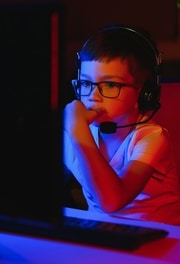Role of Multiplayer Video Games and Socially Challenged Children
Have you ever noticed that children who participate in multiplayer online video games have their own language? They have their internal jokes as well. Many children will like this distinct culture. However, it might be difficult for children who struggle with social skills.
When playing a video game with other kids, these youngsters may have the same issues in actual social interactions. Continue reading to find out how to guide your youngster through internet video games.
Multiplayer online video game culture
Culture refers to a group’s shared habits, language, and values. For example, sports lovers divide the year into seasons based on their favorite sport: football in the fall and baseball in the spring. They are devoted to their teams and may binge-watch on holidays or days when many games are scheduled. They have their slang terms, such as GOAT (greatest of all time).
Kids playing multiplayer online video games similarly have a common culture. Summer is the season for heavy playing. Throughout the year, gamers pay attention to seasonal events. They also have their vocabularies, such as noob (new or bad player) and skin (the way a player looks in a game).
However, there is a significant gap between sports and video gaming cultures. The majority of sports enthusiasts are spectators. While it is becoming more popular to watch people play video games, most gamers are active players who participate. They observe what other players are doing and how they are acting in the game. As a result, they can bully, criticize, and exclude children, just as in the real world.
As a result, children with social skill issues may have the same negative experiences online as in real life. And most of the time, their parents are completely oblivious of what is going on.
Different types of online video games
In the United States, millions of children play video games. On the other hand, parents and caregivers have less or no familiarity with gaming than with school or sports cultures. Everyone has gone to school. Not every parent has played Call of Duty or other online shooting game.
Interaction with people is not required in all video games. On the other hand, Multiplayer online video games like Minecraft and Fortnite are among the most popular. Such games are where the distinctive characteristics of video game culture emerge since kids connect online.
Role-playing is prevalent in several of these games. Children typically take on the role of a character with unique abilities and proceed through a storyline. Some games, although not all, are centered on an adventure.
Multiplayer online games include one or more of the following characteristics:
- Action-oriented: To win or get points, kids must fight, jump, dance, or do other activities throughout the game. From first-person shooter games to arcade games, this broad genre includes everything.
- Cooperative: Children work together to attain a common objective. Kids compete against one another as they play. Fortnite Battle Royale is a competitive game where participants (typically around 100) compete to be the last one standing.
Minecraft, for example, is a sandbox game incorporating cooperative and action features.
Stumbling blocks for children who struggle with social skills
Video games have a lot of advantages for youngsters who have social skills issues. Games may be a lifesaver for youngsters who struggle to connect with their classmates in real life. A gaming hobby can lead to online friendships, but it can also lead to real-life friendships.
Simultaneously, gaming culture may be extremely difficult for children who have difficulty interacting with others. Here are a few of the most common stumbling blocks and how to assist your child in overcoming them.
Trolling
For entertainment, some gamers may harass or antagonize other players. Trolling or cyberbullying is generally anonymous and unpredictable, and it occurs without notice. It may be quite distressing for children.
What you can do: If you discover that your kid is being harassed, you must take the game away from them as soon as possible. Trolls thrive on being seen. If your child fights back in the game, they may encourage further trolling. Most games offer a feature where your youngster may report a trolling gamer. Encourage your youngster to write a report in case of an issue.
Trash-talking
In multiplayer video games, damaging remarks and trash-talking from teammates and opponents are common. Sometimes taunting is lighthearted and harmless. Other times, even between friends, it turns downright unpleasant.
What you’ll need to do: If your child has problems regulating their emotions, it’s critical to establish a clear rule prohibiting them from playing with trash-talking children. Even if they are unintentional, negative comments can significantly influence your child.
Online anonymity
Being anonymous might encourage teenagers to act in ways they might not with known people. Since no one recognizes who they are, they may be cruel. This is particularly true if they are aggressive.
What you can do to help: As a virtual playdate, encourage your youngster to play games with real-life pals. Another alternative is to find a gaming community that focuses on family-friendly games.
Complex social rules
Each game has its own set of social interaction guidelines. In games, just like in real life, social rules are generally not written. They may be difficult for children to comprehend. Other players may become enraged and offended as a result of their actions.
What may be done to help:
- Learn about the game’s nature, whether it’s cooperative or competitive. You might even need to play the game yourself a few times.
- Assist your youngster in understanding the social rules.
- Try to keep your youngster focused on one game for a time so that they may learn what is proper.
Hyper competition
A competitive environment is encouraged by most video game creators as a commercial tactic to keep a game popular. This might be difficult for children who struggle with impulsivity and self-control. If they’re having trouble in the game, they could grow irritable and upset.
What you can do: Remind your youngster that a game is simply a game if they aren’t as good as other children. Assist your youngster in recognizing their other skills.
Benefits of Playing video games
Significant research on the negative impacts of gaming, such as addiction, depression, and aggressiveness, has already been published for decades. We are not arguing that you should disregard it. However, a more balanced viewpoint is required to comprehend the influence of video games on the development of children and adolescents.
According to multiple studies, one general belief is that video gaming is intellectually lazy. However, such activity strengthens a range of cognitive abilities such as spatial navigation, logic, memory, and perception. According to the study’s authors, this is especially true for violent shooter video games. As per a 2013 meta-analysis, participating in shooting games improved the player’s ability to think in three dimensions, and academic courses focused on boosting the same skills.
The previous study has shown the importance of spatial abilities for success in science, technology, engineering, and mathematics. Therefore this has significant implications for education and career development. Other sorts of video games, such as puzzles or role-playing games, do not induce similar improved thinking.
Playing video games may also help in developing problem-solving skills in youngsters. The more sophisticated video games, such as role playing games that teenagers reported playing, the more their problem solving and school grades improved the following year. Other studies found that playing video games, even violent games, increased children’s creativity.
Simple games, such as “Angry Birds,” which are easy to obtain and play, can boost players’ emotions, induce relaxation, and reduce anxiety. On the other hand, video games are good instruments for teaching failure resilience. Children develop emotional stability in their everyday lives by learning to cope with repeated failures in games.
Benefits for socially challenged children
The socially isolated gamer is another myth that the study debunks. According to the report, more than 70% of gamers play with a partner. Millions of people worldwide participate in enormous virtual worlds through video games like “Farmville” and “World of Warcraft.” Multiplayer games develop into virtual social groups. When this happens, players are required to make rapid judgments to decide who they can trust and reject and how to manage a group.
Children who play cooperative video games, even if they are violent, are more helpful in the long run to others while gaming than those who play competitively.
ADHD therapy: A prescription for gaming?
Studies have identified a technique to transform video games into therapeutic treatment. The FDA has chosen the first non-drug solution to assist children aged 8 to 12 years old having inattentive or combined-type attention-deficit/hyperactivity disorder (ADHD). It is a prescription therapy that should not be used in place of other forms of ADHD treatment, medicine, or educational materials recommended by your doctor.
According to five studies examining over 600 youngsters, the game-based digital gadget strengthened attention. Even though it is a prescription, it is no longer covered by health insurance. It costs $450 for a three-month prescription. For families who cannot afford it, the companies may be able to assist them.
How Virtual Violence Impacts Children’s Behavior
Because science and common sense don’t often agree, it’s doubly rewarding when they do. When it comes to children’s exposure to violent media, science backs up what we already know. What they watch and play affects how they act. Not only does it affect their behavior, but unhealthy gaming also impacts their overall health.
Children exposed to greater violence in their virtual worlds—television, movies, and video games—are more likely to have violent thoughts, aggressive conduct, and angry sentiments in real life.
I believe most people would accept that whatever we do to minimize this violent conduct is worthwhile.
- Try to minimize your children’s exposure to violent content if they are under the age of six. Children at this age cannot discriminate between fiction and reality. Even cartoon violence affects their perceptions of reality.
- Learn everything you can about the content that your kids watch. Take a look at the available industry and Nonprofit ratings. Allow those ratings to assist you in deciding and filtering out what you cannot allow in your home. Remember that a child’s weakest argument is “all my friends are permitted to watch it.” Take a seat and play with your kids. You’ll have a better grasp of an essential aspect of their life and have the opportunity to include an adult viewpoint on what they’re viewing. You’ll undoubtedly have opportunities to discuss and explain your family’s values.
- Examine your children’s games to see what they’re teaching them. Is violence becoming prevalent? Funny? Racist? Are users rewarded with money or status? Or are the severe, long-term effects of violence shown dramatically? You can give children a more realistic view of the effects of violence and the perspective they require.
- Feel free to prevent your children from playing video games that encourage shooting, murdering, or injuring others. Video games may be effective instructors, teaching youngsters how to collaborate and support one another and multitask in specific ways. On the other hand, video games can encourage a sense of perpetual threat and a positive reward for aggressiveness. Violence does not need to be an element of entertainment in the gaming industry because there is so much exciting stuff.
Conclusion
Video games aren’t going away anytime soon. In reality, most experts think that the gaming business will continue to expand – and that it will increasingly target younger children. Make sure you’re participating if your child plays video games, especially multiplayer online games, so that you can assist resolve any issues.
Gaming culture might be complex for children who have difficulty interacting with others. When trolling or trash-talking occurs, it’s critical to shut the video game down immediately. Encourage your youngster to play online video games with their real-world buddies.
People have hoped and prayed for world peace, but no one anticipates aggressiveness or bloodshed to be eradicated from our lives. However, we know that assisting our children in selecting less violent entertainment may significantly impact their behavior for certain children, and that’s a great place to start.





 Explore the Safe Search Engine -
Explore the Safe Search Engine -